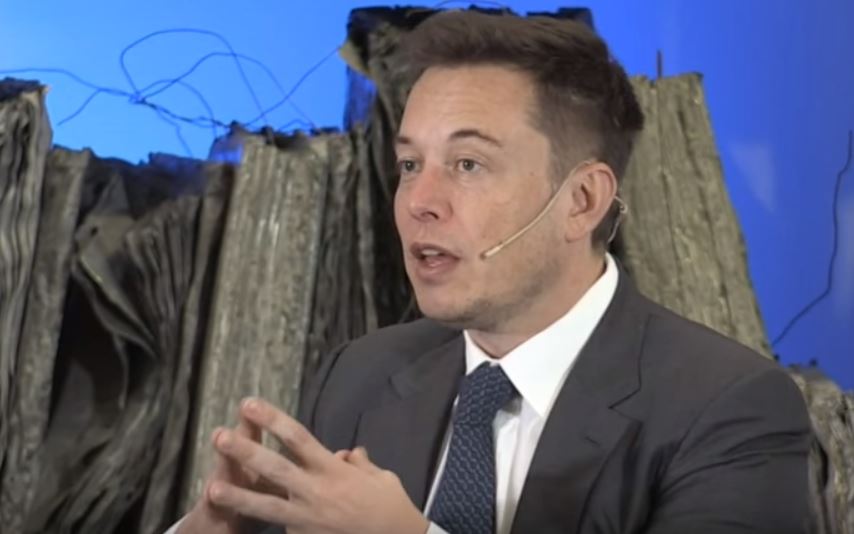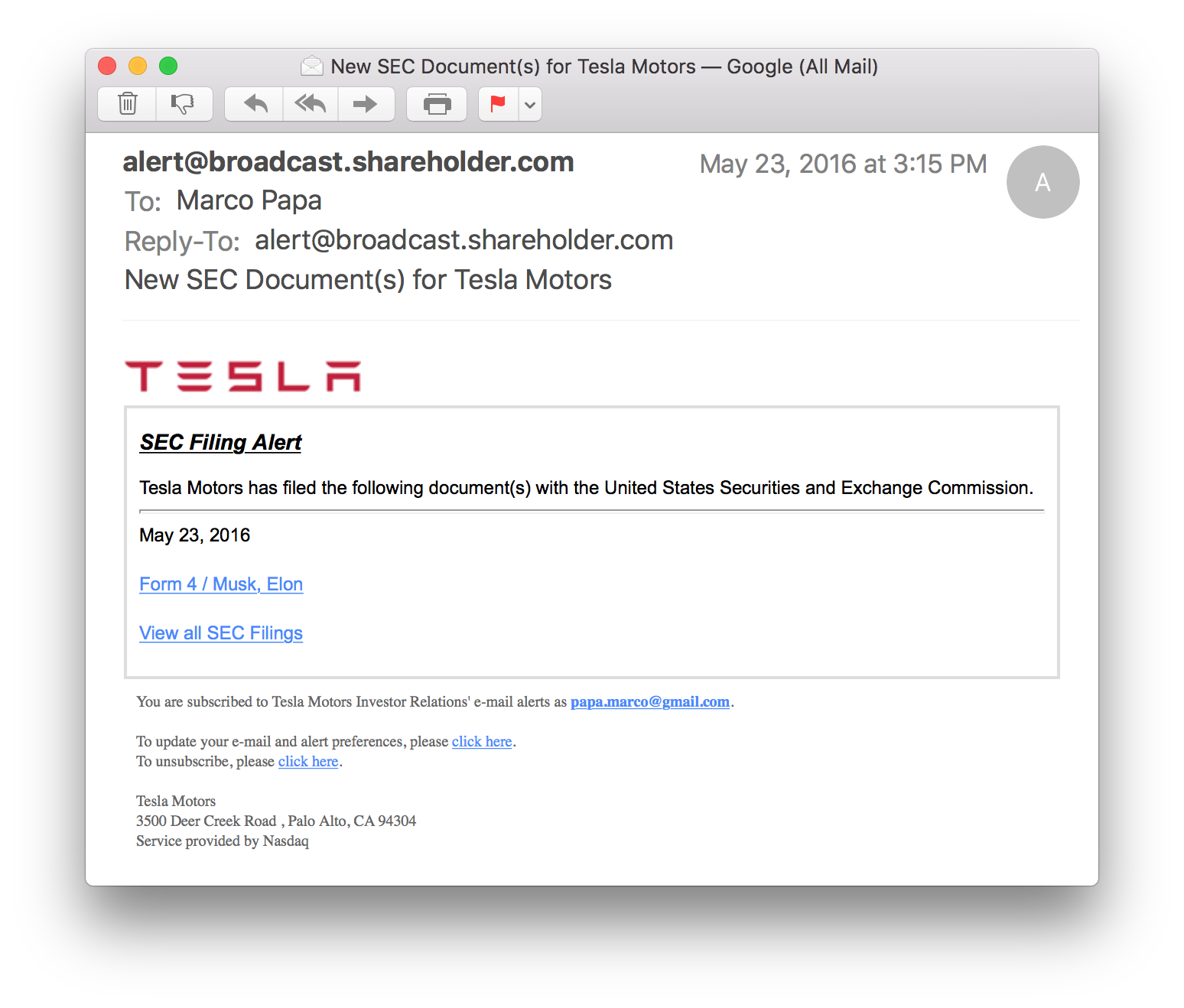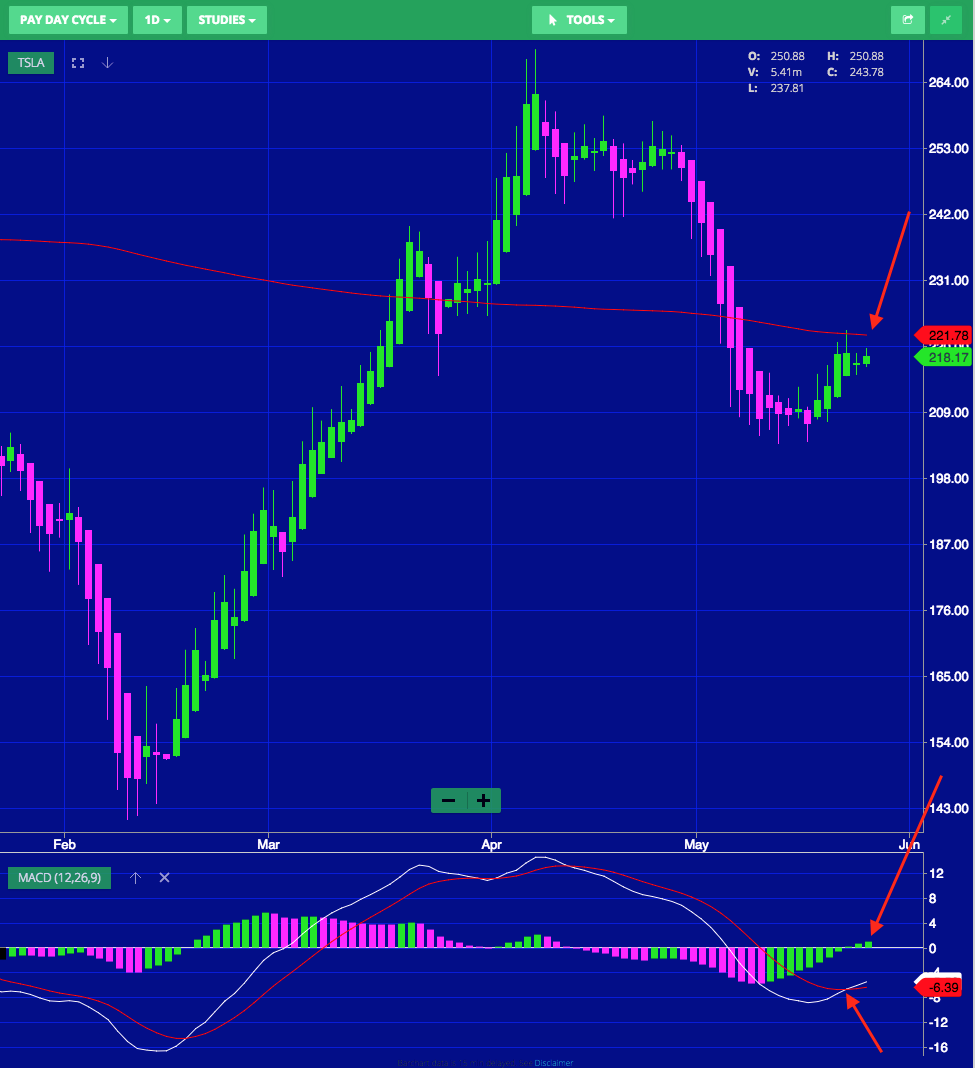Investor's Corner
Debunking the story that Elon Musk “kept cash” from the recent stock offering

On Monday May 23, 2016, Tesla Motors e-mailed to TSLA registered investors a link to Elon Musk’s Form 4 SEC Filing, a.k.a. the Statement of Changes in Beneficial Ownership, detailing the transactions that are part of the recent stock offering that relate to Elon Musk.

Source: Tesla Motors
The Form is available also at Tesla Motors Investors website.
I will go through the major details shown in the form to understand how the transactions were executed. For the inquiring minds, the various SEC codes listed in FORM 4 can be found here.
First an assumption: prior to the offering and the changes in beneficial ownership of the listed securities, Elon Musk held 29,579,342 shares of stock in TSLA.
The first and second transactions (Table I, column 1, line 1 and 2) report the exercise of stock options (options that were awarded to Elon in previous years as part of a Non-Qualified Stock Options plan) to acquire 5,503,972 shares of Tesla’s common stock (2,147,986 + 3,355,986 shares). The options were originally awarded at $6.63, and Elon paid $36,491,334 or about $36 million to exercise them. After this purchase, Elon owned at total of 35,083,314 shares (Table I, column 5, line 2).
While the original offering was supposed to be priced at about $204 per share, the eventual offering price was raised to $215 per share. At the $215 stock value at the time of the offering, the value of the acquired shares was a whopping $1.18 billion!
Before actually paying for the option exercise transactions, Elon did two things.
First it disposed of 1.2 million shares as a “bona file gift to charity” (Table I, line 3 and Explanation of Responses (3)). This gift reduced Elon’s shares down to 33,883,314 shares (Table I, column 5, line 3).
Second, Elon disclosed that he intended to sell 2,782,670 of the purchased shares in the “registered offering solely in order to pay income tax related to these stock option exercises” (see Explanation of Responses (2) in FORM 4). The sale reduced Elon’s shares further down to 31,100,644 shares. At $215 / share, Elon Musk’s Tesla shares are worth a bit over $13 billion.
Interestingly, if these were Incentive Stock Options (ISO), the ones usually awarded to Executives, vs. Non-qualified Stock Options (NSO), usually awarded to regular employees, these options would have received special federal tax treatment, and there would be no taxable event reported at exercise, except for any exercised shares that were sold immediately after the exercise. But as one can see in Table II, Elon received “non-qualified stock options” like any other employee, that do not qualify for special tax treatment.
The gain or “bargain element” in a stock option exercise is calculated by subtracting the exercise price ($6.63) from the market price ($215) of the company stock on the date the option is exercised. So the gain per share is $208.70. The total bargain element (gain) in the options exercise transactions is $1,148,679,000 or about $1.14 billion, which is the “taxable gain.”
For the 2,782,670 shares that Elon sold in the registered offering, Elon collected $598,274,050 or about $580 million after accounting for the price paid for the shares. Since these shares were sold immediately after exercise, the gain will be reported as a short-term capital gain and will be subject to tax at ordinary income tax rates. Assuming 39.6% ordinary federal income tax rate, and a 12.30% top individual rate for California, Elon would have to pay $596 million in tax, or 51.9% of the “taxable gain.”
Notice that the $580 and $596 million numbers above are close enough for the company to state in the FORM 8-K filing that “Mr. Musk will owe a significant amount of taxes from exercising these stock options and will fund this task obligation by selling only the amount of shares needed to do so.”
But we are not done. The rest of the stock exercised by Elon Musk, 2,731,302 shares, can be treated as long-term capital gain (with better tax treatment, likely at the 20% long-term capital gain rate, rather than at the 39.6% personal income tax rate) if the stock is held for 12 months after exercise. Assuming that Elon is smart (I think he is), he will wait, to get a combined Federal + California 32.3% tax rate, resulting in an additional $184 million in taxes (2,731,302 times $208.70 times 32.3%).
Finally, we need to consider the gift of 1.2 million shares of Tesla’s common stock given to charity (Table I, column 1, line 3). By donating shares, Elon avoids paying the capital gains tax, which would have to be paid if the shares were first sold and then the cash proceeds donated to charity.
Moreover, Elon can get a tax deduction for the current fair market value of the gifted shares. In general, the amount of the deduction is limited to 20%-30% of the adjusted gross income, but one can carry forward amounts above that for up to five years. Without knowing Elon’s adjusted gross income, it is difficult to guess what the deduction would amount to. The fair market value of the donated shares is $250 million. That would be the best case scenario for a charitable deduction, which is extremely unlikely, while 20% of the taxable gain is more likely ($218 million).
Summarizing the transactions:
- Cost of exercising options: $36 million
- Taxes on short-term capital gain for shares sold at offering: $596 million
- Taxes on long-term capital gains for shares held 12-months: $184 million
Total outlay: $ 816 million
- Registered offering sale: $580 million
- Gifted shares tax deduction (max): $250 million, (likely): $218 million
So after all is said and done, Elon will still owe Uncle Sam between $18 and $236 million. I have seen reports from “TSLA bears” (or TSLA haters, same thing) indicating that Elon would actually “keep cash” on this sale.
Obviously he does not, and I would expect that he would eventually have to sell a portion of the remaining $1.5 million (to be exact 1,521,302 shares) from the offering that Elon is not selling or donating to charity, to cover the additional tax, unless he’s got cash in the bank to pay for it.
This offering dilutes the total outstanding shares of TSLA with an additional 1.4 million from Tesla Motors and the 5.5 million from Elon Musk (for a total on 6.9 million new shares diluting the TSLA public pool of shares), while Elon adds about 1.5 million to his total, ending with about 31 million shares (to be exact 31,100,644). So Elon adds some shares but loses a bit in Tesla ownership percentage, from 26.2% to 22.7%.
Technical Analysis
Looking at this week TSLA action, we are now after my predicted breakout, looking at bullish pay-day-cycles (6 consecutive green Heikin Ashi bars), the MACD gone positive, and the MACD moving averages “crossed to the bulls”.
We are coming close to an important point: the stock price is advancing toward the 200-day moving average (around $221.90), which will act as “resistance”. If the stock fails to cross the 200-day moving average, it would usually move down and fast afterwards (“bounce” off the average); this morning it traded as high as $220.75 and “bounced”. If otherwise it eventually crosses the 200-day moving average, we will have an additional bullish indicator and the stock will be header for new tops.
I entered my option trades last week (Sept. 215 calls), before the breakout and have added and cashed in already once to take profits. I have also progressively moved up my conditional stop from 205, to 210 and 215, to protect my profits, and will likely move it even higher as the stock approaches the 221 level and tests the resistance. If the stock crosses the 200-day moving average, I will add again to my TSLA calls holdings, as I will have 4 bullish indicators flying high. Obviously not a good time for short sellers in $TSLA.

Investor's Corner
Tesla stock closes at all-time high on heels of Robotaxi progress

Tesla stock (NASDAQ: TSLA) closed at an all-time high on Tuesday, jumping over 3 percent during the day and finishing at $489.88.
The price beats the previous record close, which was $479.86.
Shares have had a crazy year, dipping more than 40 percent from the start of the year. The stock then started to recover once again around late April, when its price started to climb back up from the low $200 level.
This week, Tesla started to climb toward its highest levels ever, as it was revealed on Sunday that the company was testing driverless Robotaxis in Austin. The spike in value pushed the company’s valuation to $1.63 trillion.
Tesla Robotaxi goes driverless as Musk confirms Safety Monitor removal testing
It is the seventh-most valuable company on the market currently, trailing Nvidia, Apple, Alphabet (Google), Microsoft, Amazon, and Meta.
Shares closed up $14.57 today, up over 3 percent.
The stock has gone through a lot this year, as previously mentioned. Shares tumbled in Q1 due to CEO Elon Musk’s involvement with the Department of Government Efficiency (DOGE), which pulled his attention away from his companies and left a major overhang on their valuations.
However, things started to rebound halfway through the year, and as the government started to phase out the $7,500 tax credit, demand spiked as consumers tried to take advantage of it.
Q3 deliveries were the highest in company history, and Tesla responded to the loss of the tax credit with the launch of the Model 3 and Model Y Standard.
Additionally, analysts have announced high expectations this week for the company on Wall Street as Robotaxi continues to be the focus. With autonomy within Tesla’s sights, things are moving in the direction of Robotaxi being a major catalyst for growth on the Street in the coming year.
Elon Musk
Tesla needs to come through on this one Robotaxi metric, analyst says
“We think the key focus from here will be how fast Tesla can scale driverless operations (including if Tesla’s approach to software/hardware allows it to scale significantly faster than competitors, as the company has argued), and on profitability.”

Tesla needs to come through on this one Robotaxi metric, Mark Delaney of Goldman Sachs says.
Tesla is in the process of rolling out its Robotaxi platform to areas outside of Austin and the California Bay Area. It has plans to launch in five additional cities, including Houston, Dallas, Miami, Las Vegas, and Phoenix.
However, the company’s expansion is not what the focus needs to be, according to Delaney. It’s the speed of deployment.
The analyst said:
“We think the key focus from here will be how fast Tesla can scale driverless operations (including if Tesla’s approach to software/hardware allows it to scale significantly faster than competitors, as the company has argued), and on profitability.”
Profitability will come as the Robotaxi fleet expands. Making that money will be dependent on when Tesla can initiate rides in more areas, giving more customers access to the program.
There are some additional things that the company needs to make happen ahead of the major Robotaxi expansion, one of those things is launching driverless rides in Austin, the first city in which it launched the program.
This week, Tesla started testing driverless Robotaxi rides in Austin, as two different Model Y units were spotted with no occupants, a huge step in the company’s plans for the ride-sharing platform.
Tesla Robotaxi goes driverless as Musk confirms Safety Monitor removal testing
CEO Elon Musk has been hoping to remove Safety Monitors from Robotaxis in Austin for several months, first mentioning the plan to have them out by the end of 2025 in September. He confirmed on Sunday that Tesla had officially removed vehicle occupants and started testing truly unsupervised rides.
Although Safety Monitors in Austin have been sitting in the passenger’s seat, they have still had the ability to override things in case of an emergency. After all, the ultimate goal was safety and avoiding any accidents or injuries.
Goldman Sachs reiterated its ‘Neutral’ rating and its $400 price target. Delaney said, “Tesla is making progress with its autonomous technology,” and recent developments make it evident that this is true.
Investor's Corner
Tesla gets bold Robotaxi prediction from Wall Street firm
Last week, Andrew Percoco took over Tesla analysis for Morgan Stanley from Adam Jonas, who covered the stock for years. Percoco seems to be less optimistic and bullish on Tesla shares, while still being fair and balanced in his analysis.

Tesla (NASDAQ: TSLA) received a bold Robotaxi prediction from Morgan Stanley, which anticipates a dramatic increase in the size of the company’s autonomous ride-hailing suite in the coming years.
Last week, Andrew Percoco took over Tesla analysis for Morgan Stanley from Adam Jonas, who covered the stock for years. Percoco seems to be less optimistic and bullish on Tesla shares, while still being fair and balanced in his analysis.
Percoco dug into the Robotaxi fleet and its expansion in the coming years in his latest note, released on Tuesday. The firm expects Tesla to increase the Robotaxi fleet size to 1,000 vehicles in 2026. However, that’s small-scale compared to what they expect from Tesla in a decade.
Tesla expands Robotaxi app access once again, this time on a global scale
By 2035, Morgan Stanley believes there will be one million Robotaxis on the road across multiple cities, a major jump and a considerable fleet size. We assume this means the fleet of vehicles Tesla will operate internally, and not including passenger-owned vehicles that could be added through software updates.
He also listed three specific catalysts that investors should pay attention to, as these will represent the company being on track to achieve its Robotaxi dreams:
- Opening Robotaxi to the public without a Safety Monitor. Timing is unclear, but it appears that Tesla is getting closer by the day.
- Improvement in safety metrics without the Safety Monitor. Tesla’s ability to improve its safety metrics as it scales miles driven without the Safety Monitor is imperative as it looks to scale in new states and cities in 2026.
- Cybercab start of production, targeted for April 2026. Tesla’s Cybercab is a purpose-built vehicle (no steering wheel or pedals, only two seats) that is expected to be produced through its state-of-the-art unboxed manufacturing process, offering further cost reductions and thus accelerating adoption over time.
Robotaxi stands to be one of Tesla’s most significant revenue contributors, especially as the company plans to continue expanding its ride-hailing service across the world in the coming years.
Its current deployment strategy is controlled and conservative to avoid any drastic and potentially program-ruining incidents.
So far, the program, which is active in Austin and the California Bay Area, has been widely successful.









